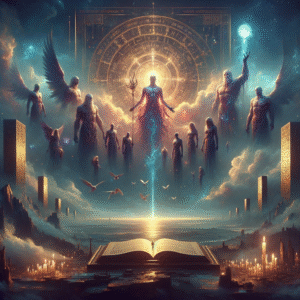How are Nephilim depicted in modern conspiracy theories? The Nephilim, enigmatic beings mentioned in ancient texts, have long captivated human imagination. These figures, often described as giants born from the union of the “sons of God” and the “daughters of men,” have transcended their biblical origins to become prominent symbols within modern conspiracy theories. This article explores how the Nephilim have been woven into contemporary conspiratorial narratives, examining the ways in which ancient myths have been reinterpreted to fit modern contexts.

Nephilim in the Realm of Modern Conspiracies
In the realm of modern conspiracy theories, the Nephilim have often been depicted as the shadowy architects behind secretive world orders. Many conspiracy theorists propose that these ancient beings, or their descendants, continue to influence global events from behind the scenes. This notion stems from the belief that the Nephilim, with their alleged superhuman abilities and knowledge, have survived throughout the ages, manipulating human civilizations to further their own ends. Such theories often draw connections between the Nephilim and various elite groups, suggesting that the giants of old have evolved into today’s ruling class.
One popular conspiracy theory posits that the Nephilim are linked to ancient alien narratives. Proponents of this view argue that the biblical descriptions of the Nephilim are actually accounts of extraterrestrial beings interacting with humans. This theory is often supported by alleged evidence of advanced ancient technologies, which some claim could only have been developed with the assistance of otherworldly entities. The idea that the Nephilim may have been extraterrestrial visitors ties into broader theories about alien involvement in human history, suggesting that these beings may return one day to reclaim their dominance.
The Nephilim are also frequently associated with theories concerning hidden archaeological findings. Conspiracy theorists often claim that there is a concerted effort to suppress evidence of giant skeletons and other artifacts that would prove the existence of the Nephilim. Such theories argue that mainstream academia, in collusion with powerful institutions, deliberately obscures these discoveries to maintain current historical narratives. These claims are fueled by anecdotal reports and unverified photographs of alleged giant remains, which circulate widely in conspiracy forums and websites.
Examining Myths: How Are Nephilim Depicted Today?
Today’s depictions of the Nephilim in the context of conspiracy theories reflect a broader trend of reinterpreting ancient myths to address contemporary anxieties. The portrayal of the Nephilim as nefarious, powerful entities taps into common fears about loss of control and the influence of unseen forces. This is especially prevalent in a world increasingly driven by complex technological and political systems, where the idea of a hidden hand guiding global events is both compelling and unsettling. The Nephilim serve as a convenient symbol for these fears, encapsulating the notion of an ancient, enduring power that transcends human limitations.
Moreover, the connections drawn between the Nephilim and extraterrestrial theories illustrate how modern narratives often blend historical and speculative elements. By associating the Nephilim with aliens, these theories create a hybrid mythology that bridges ancient texts and contemporary science fiction. This fusion allows proponents to draw on a wide array of cultural references, making their theories more accessible and engaging to a diverse audience. It also demonstrates how the reinterpretation of ancient myths can evolve to incorporate modern scientific concepts, such as the possibility of life beyond Earth.
Nephilim-focused conspiracy theories also reflect a distrust of authoritative narratives, particularly those endorsed by scientific and academic institutions. The notion of suppressed evidence regarding the giants speaks to a broader skepticism towards established knowledge systems. As these theories gain traction, they highlight the tension between mainstream historical interpretations and alternative viewpoints that seek to challenge the status quo. This dynamic underscores the role of conspiracy theories in questioning and reimagining history through the lens of personal belief and cultural mythology.
The depiction of Nephilim in modern conspiracy theories exemplifies how ancient myths can be repurposed to address contemporary concerns and curiosities. By positioning these mysterious figures as central players in grand conspiracies, theorists weave a narrative that connects the past and present, the terrestrial and the extraterrestrial. As these stories continue to evolve, they reflect our enduring fascination with the unknown and our propensity to seek explanations beyond conventional boundaries. Whether seen as ancient giants or alien progenitors, the Nephilim remain a potent symbol in the ever-expanding tapestry of modern speculative thought.


Comments Feed
This page is used for syndicating comments across the website. If you’re looking for more engaging content, check out our latest articles and insights:
Stay connected with our latest teachings and insights by subscribing to our newsletter:
Subscribe Now